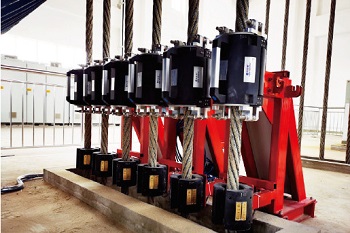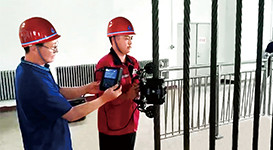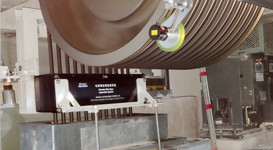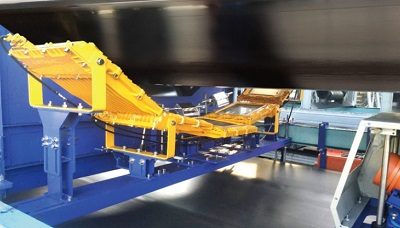
|

|

|

|
Steel wire rope is widely used in multiple important fields of the national economy. For many years, there have been prominent safety hazards, poor economy, and significant accident risks in the use of steel wire rope, which are worldwide problems. Currently, the domestic coal system still uses manual detection methods for steel wire rope safety management, resulting in continuous lifting and transportation accidents in the coal system for many years, causing huge losses. Based on the current status of steel wire rope use in coal mines, combined with their own actual situation and experience in using steel wire rope, Fengfeng Group has introduced advanced TCK.W weak magnetic detection technology to conduct scientific and quantitative detection of steel wire rope in use, and has taken the lead in establishing an online real-time monitoring system for steel wire rope in the domestic coal system. They have made effective explorations in the scientific and safe use of steel wire rope.
As the main component of lifting, transportation, lifting, and load-bearing equipment and facilities in various fields of the national economy such as mines, metallurgy, construction, water conservancy, tourism, port terminals, transportation, aerospace, oil exploration, and military industry, steel wire rope is widely used. In mine lifting and transportation equipment, the use of steel wire rope is very common.
For a long time, due to the complex structure, severe operating environment and irreversible damage (irreversible damage), the use and management of steel wire rope have always been difficult points and even "blind spots" in the equipment management of coal enterprises. Steel wire rope has also become a major hidden danger to enterprise safety production for many years, with accidents happening continuously. Fengfeng Group is a state-owned key coal mine, and has also experienced many wire rope breakage accidents, resulting in direct equipment losses and indirect economic losses.
From the national perspective, according to the statistics from the "China Coal Mine Accidents and Expert Commentaries Collection", from 1949 to 1995, in the national coal mine transportation and lifting accidents, a total of 19,871 people were killed, accounting for 15.06% of the total number of coal mine deaths. It is only second to gas and roof accidents and is the third major disaster accident in the coal system. During this period, state-owned key coal mines had a total of 91 transportation and lifting accidents with more than 3 deaths, resulting in 421 deaths. Among them, 34 were steel wire rope breaking accidents, accounting for 37.36%, resulting in 193 deaths, accounting for 45.84%. Therefore, the safe use of steel wire rope has attracted a lot of attention. However, in sharp contrast to the frequent steel wire rope accidents in the coal industry over the years, the use and management of steel wire rope have been stuck at a low level and low level for many years, resulting in serious problems in the safe use of steel wire rope in coal mines and other industries' lifting equipment.
1 Strengthen technological innovation and explore the path of wire rope use and scientific management
Fengfeng Group currently operates over 60 large lifting equipment of various types, with an annual steel wire rope usage of approximately 1240 tons and a cost of approximately 10.5 million yuan. How to scientifically manage and use steel wire rope has always been a difficult problem. As everyone knows, the main and auxiliary shafts in coal mines are the "throat" of coal production. Steel wire rope is an important component of the main and auxiliary shaft lifting equipment, which is directly related to the normal production of coal mines, the safety of personnel lives, and economic operation. To ensure the safe operation of coal mine lifting equipment, the "Coal Mine Safety Regulations" (hereinafter referred to as the "Regulations") have detailed regulations on steel wire rope for lifting. Currently, many domestic companies that master advanced steel wire rope production technology have gradually taken the lead in production capacity and technology level towards internationalization, and have the ability to produce high-strength, high-toughness, low-relaxation, and uniform捻quality steel wire rope. The main technical performance of these domestically produced steel wire ropes can be controlled and meet design requirements; the structure elongation and cross-section reduction rate of the steel wire rope satisfy design requirements; the breaking tensile force of the whole rope meets the standard requirements, and the tension between each strand of rope is uniform; the oil content of the core meets the lubrication requirements of the steel wire during use; in the process of rope making, the configuration of rope diameter and wire diameter is scientific, Once the structure and diameter of steel wire rope are determined, the wire diameter can be accurately controlled at 0.01mm; there is a quantitative control of gaps between wires and strands, as well as standardized requirements for crystal grain size, axial compression rate of core; when the steel wire rope is untwisted for mechanical property testing, the tensile strength, bending value and torsion value of each steel wire can be uniformly controlled within a certain range under conditions that meet standard requirements.
However, the use and management of steel wire rope continue to rely mainly on mine design and selection. According to convention, except for a few steel wire ropes that have exceeded the regulations of the "Coal Mine Safety Regulations" due to broken wires, wear and other performance indicators, most of them adopt the method of regular replacement of steel wire ropes, and still cannot scientifically select and use management according to the production situation and use environment of the mine. What is more is that due to the backwardness of the detection method, it is impossible to grasp the actual damage situation and fatigue level of the steel wire rope in use, which inevitably leads to potential safety hazards and the sacrifice of available resources for safety. How can we achieve a scientific selection of steel wire rope models, grades, and anti-corrosion forms based on the production situation and use environment of the mine, so as to achieve both economy and safety? What quantitative relationship exists between internal and external damage to steel wire rope that reduces the cross-section area of the load-bearing steel wire rope and the decrease in the breaking force of steel wire rope? Can online detection of the actual carrying capacity of steel wire rope be used to grasp the safe status of steel wire rope in use at any time? If these problems can be solved, then it will provide a basis for the selection of steel wire rope, realizing standardized and scientific use and management of steel wire rope. Fengfeng Group Company has made the following explorations in this regard.
(1) Scientific and reliable detection technology and detection methods exploration. To solve the quantitative detection problem of steel wire rope, Fengfeng Group Company has investigated the application situation of steel wire rope detection technology at home and abroad. Since the beginning of the 20th century, international researchers have started to develop non-destructive testing devices for steel wire rope, which has a history of nearly 100 years. In the 1960s, China also began to develop such devices. Internationally, the detection methods that have been theoretically explored include: acoustic detection method, mechanical detection method, radiation detection method, current detection method, optical detection method, eddy current detection method, ultrasonic detection method, vibration detection method, acoustic emission detection method, and magnetic detection method. Currently, only the magnetic detection method has been widely applied in detecting defects in steel wire rope. Existing steel wire rope flaw detectors are based on two magnetic detection principles: strong magnetic detection technology and weak magnetic detection technology. Strong magnetic detection technology has been widely applied, but for 100 years, there has been no significant technological breakthrough in strong magnetic detection technology, and corresponding products cannot fully meet the requirements of industrial applications. Conventional strong magnetic detection methods include: LF magnetic flux leakage method, LMA/LF main magnetic flux method, and LMA/LF loop magnetic flux method. Corresponding detection components include induction coils, Hall elements, and magnetic flux gates. The common defects of these detection methods are low magnetic sensitivity (about 12mV/mA·T), large temperature drift, complex and unreliable sensor circuit structure, systematic errors in the operation process, and the influence of detection speed.
At the beginning of the 21st century, weak magnetic detection technology has made breakthrough development, and new instruments based on weak magnetic detection technology have also been further improved, which has become an inevitable trend to replace traditional strong magnetic detection technology.
Fengfeng Group Company has noticed the TCK.W steel wire rope detection technology, which is the only weak magnetic detection method used domestically and globally. This technology is a major breakthrough in the global steel wire rope detection field developed by the R&D personnel of TCK.W Steel Wire Rope Detection Technology Co., Ltd. Theoretically, through studying the relationship between damage field strength and various magnetic field vector variables, their sum and difference relationship is established with the mathematical model of steel wire rope damage area △S. By monitoring the main leakage magnetic field Hz, local leakage magnetic field Hi (ie: local leakage magnetic field Hd caused by internal and external broken wires, local leakage magnetic field Hm caused by internal and external wear, local leakage magnetic field Hx caused by internal and external corrosion, and other local leakage magnetic fields Hq caused by section reduction, steel wire welding points, etc.) to determine the internal and surface defects of steel wire rope, and it is proved through experiments. As shown in Figure 1, a detecting ring is taken around the steel wire rope to detect the magnetic flux density or magnetic field strength in the area of the detecting ring, so as to determine the damage area △S.
B=μH
其中:μ——导磁率
在空气和真空中μ=1
所以:H = B H∞△S
△S0 =∫∫h(x,y)dxdy
△S0max =∫ d0 ∫ h(r Cosθ, r Sinθ)rdr △S0max =0→2π △S0min =0→0
By assembling m sensors around the ring and forming a pattern recognition-type ring sensor, not only can the physical quantity of a certain point field strength be identified, but also the spatial position of the steel wire rope damage point can be identified. The area of steel wire rope damage point △S becomes a function of field strength Hi.
Experiments have shown that this is completely correct and the operation speed is very fast. The establishment of this mathematical model has fully satisfied the detection of defects such as broken wires. Rust, wear, fatigue, deformation, etc. can also be detected in the lay length. This new technology has achieved quantitative detection of various types of steel wire rope damage and solved the problem of quantitative detection of steel wire rope.
(2) In combination with long-term physical testing methods, in-depth exploration has been conducted on the relationship between the reduction rate of steel wire rope diameter and the reduction rate of breaking force. As we all know, internal and external wear of steel wire rope reduces the load-bearing area of steel wire, and the breaking load of steel wire rope is also reduced correspondingly. Based on physical breaking force data analysis of a large number of new and old steel wire ropes, the relationship curve between the reduction rate of steel wire rope diameter and the reduction rate of breaking load is shown in the following figure.

Figure 2: Relationship curve between the reduction rate of wire rope diameter and the reduction rate of breaking load
(3) Exploration of the relationship between steel wire rope safety coefficient and its service life. As steel wire rope is loaded, it undergoes a slight elongation. When the load exceeds the elastic limit, the steel wire rope may fracture. Usually, the static load borne by the steel wire rope is controlled within the safe load limit. However, in reality, the steel wire rope is often in motion and, in addition to carrying cargo, lifting objects, self-weight and other static loads, it also experiences dynamic loads caused by acceleration and impact, additional loads caused by bending, and resistance loads caused by friction. Therefore, when other loads except the static load increase, the actual safety coefficient decreases. In addition, according to Article 401 of the "Regulations", if the safety coefficient of the steel wire rope used for lifting and hoisting falls into one of the following situations, it must be replaced: 1. For lifting personnel with a safety coefficient less than 7; 2. For lifting personnel and materials with a safety coefficient less than 7 when lifting personnel and less than 6 when lifting materials; 3. For lifting materials and hanging the lifting platform with a safety coefficient less than 5. In practical applications, is it reasonable to choose a safety coefficient of 7.1 or even 10.1 or higher for a lifting steel wire rope? Through studying the relationship between the safety coefficient of a specific lifting device's lifting steel wire rope and its service life, we can provide scientific evidence for scientifically and reasonably selecting steel wire rope.
The following figure shows the relationship curve between the safety factor obtained from the experiment and the service life of the steel wire rope.

Figure 3: Relationship between safety factor and steel wire rope life
2 Establish a scientific management system
To ensure the safe use of steel wire rope, through long-term exploration of the management and detection technology of in-use steel wire rope, Fengfeng Group Company has recognized the necessity to establish a scientific management system for in-use steel wire rope. Therefore, Fengfeng Group Company has established a safety management system for major mine lifting equipment, with TCK.W low-magnetic detection technology as the core, to detect the internal and external wear, broken wires, corrosion, and fatigue damage of steel wire ropes. Through this system, it is possible to analyze the degree of damage to the detected steel wire rope and determine whether it needs to be replaced according to the statutory judgment rules of MT/T970-2005.
(1) Implement on-line detection of in-use steel wire ropes. Currently, most steel wire rope detectors at home and abroad have restrictions on the running speed of steel wire ropes, generally at 0-8m/s. However, this low-magnetic detection technology does not depend on the running speed of steel wire ropes, creating conditions for online detection as shown in Figure 4.

Figure 4: Steel wire rope detection device
(2) Establish a safety management system for steel wire rope use. As online detection of steel wire rope was implemented, Fengfeng Group Company collected a large amount of on-site data on the working conditions of in-use steel wire rope. Through analysis of the working condition data and numerous physical tests and dismantling observations on steel wire rope, Fengfeng Group Company established a safety management system for steel wire rope use. The system comprehensively analyzes factors such as the type of steel wire rope, manufacturer, and other information to set a limit for each factor, and compares the damage level of the in-use steel wire rope detected online with the limit. If the damage is less than 30% of the limit, it is considered light damage and as continue use; if the maximum damage is between 30% and 60% of the limit, it is considered moderate damage and as strengthening maintenance; if the maximum damage is between 60% and 80% of the limit, it is considered relatively heavy damage and as strengthening monitoring; if the maximum damage is between 80% and the limit, it is considered serious damage and as replacement in the near future; if the maximum damage reaches or exceeds the limit, it is considered over limit damage and判定as stopped using.
Conclusion
It is even more important to manage the entire process of the in-use steel wire rope, from its factory to its use and even to its scrapping process, rather than just conducting safety testing on the steel wire rope in the process of safely using the lifting equipment. Detection and online monitoring of steel wire rope are only one link in the steel wire rope management system. How to deal with the detection results and how to propose countermeasures for the use of steel wire rope based on the detection results, i.e., evaluation and diagnosis of steel wire rope usage, daily maintenance, and disposal plans, are more important research directions for steel wire rope management.
Currently, according to the investigation and research of Fengfeng Group on steel wire rope users in the national coal mining system, what enterprises really need is not only damage detection, but also how to maintain and protect steel wire rope through damage detection. How to adjust the use of steel wire rope, and how to adjust the operating conditions of lifting equipment according to the damage of steel wire rope is a more important research direction. Based on the online detection and monitoring system of steel wire rope, Fengfeng Group is currently developing a steel wire rope database to establish a steel wire rope full-process management system that fills the gap in China's leading international level. This system manages the entire process of steel wire rope from purchase, storage, transportation, use, detection, maintenance to replacement.
Author: Zhang Buqin (1962), male, Han nationality, senior engineer in machinery and electricity, bachelor's degree. He graduated from Shanxi Coal Mining Academy in August 1984 and is currently serving as the Deputy Director of Coal Production Department of Fengfeng Group for mechanical and electrical management work.
上一篇: 钢丝绳在线自动监测系统研究
下一篇: 同煤集团使用TCK.W钢丝绳检测技术报告
The application of TCK.W wire rope detection technology in academic journals
Editor's note: TCK.W has developed a weak magnetic rope detection technology that can real-time monitor the status of steel ropes 24 hours a day, 365 days a year, and locate, classify, and quantitatively identify various internal and external defects. Currently, more than 2,500 clients in 42 countries worldwide are using this technology. These clients have published papers on the safety and economic benefits brought about by this new technology in various academic journals. Here is a compilation of some of these papers for experts and scholars to explore and study in depth.。
论文名称
作者单位

 publish:《Coal mine safety》
publish:《Coal mine safety》